Martial Arts: Chinese Arts
 |
DVD:
In Our E-Store
Sifu Liu's Feeding Crane
Combat Applications & Kata
|
Finding Thunder: Exploring The White Crane Kung Fu of Liu Chang I - Part 2
By Christopher Caile
Editor's Note: This is the second article of two about Chinese Feeding Crane (a form of White Crane Kung Fu), a system that influenced the development of Okinawan karate. Part I introduced the system, and provided an overview and information about the system's unique form of power generation. Part 2 focuses on technique, control and how the system is practiced.
Feeding Crane Technique
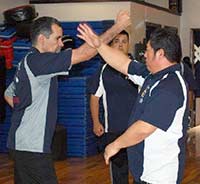 |
Sifu Liu demonstrates a one arm interception of a punch. Soft circular one and two arm interception, capture and control techniques typify Feeding Crane Kung Fu. |
In technique, Feeding Crane is soft and hard, often softness followed by hardness. Softer circular movements are used to block, intercept and control attacks. The principle is to control the first attack and the attacker, not just to avoid, evade and counter. This is also the guiding tactical principle of most Okinawan kata. (1) But unlike modern karate, Feeding Crane uses natural stepping and postures guided by function as opposed to rigidly defined stances used by most of karate today. (2)
These same soft, rounded open hand interception techniques are found in much of Okinawan karate, most directly in many old Shorin-Ryu karate kata but also in Goju-Ryu and Uechi-Ryu karate. (3)
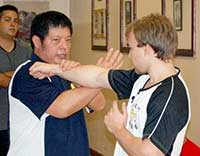 |
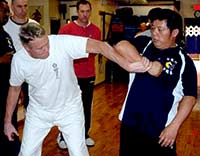 |
Sifu Liu shows a two arm circular capture technique, his left hand controlling the attacker's wrist, the right hand ready for a counter or other technique. |
Sifu Liu Chang'I demonstrates on Christopher Caile how a wrist grab can be tuned into an arm control technique. |
Once an attack is intercepted Feeding Crane often turns hard using quick powerful breaks and joint dislocations powered by quick (almost spasmodic) violent body action (known in the Chinese arts as "fa jin" or "jin" -- an explosive whip-like full body intense action). Targets are the opponents eyes, elbows, wrists, fingers, shoulders, ribs, collar bone -- anything that can be injured with emphasis joint injury, dislocations, strains and breaking. It reminded me of Hawaiian Lua. (4) Breaks are less emphasized in Okinawan karate kata. In Goju-Ryu kata breaks are more numerous, but they can also be found disguised within Shorin-Ryu kata. (5)
Unfortunately, most modern karate, especially sports karate prohibit, these techniques as dangerous -- thus cutting off the depth of old Okinawan karate. But Sifu Liu brings many of them alive again. I recognized many of the techniques. They jumped out at me from my own kata -- that old knowledge lost to most modern karate practitioners.
In Feeding Crane there are also powerful counter strikes using every part of the body, such the fist, elbow, forearm, shoulders, waist, one following the other in staccato fashion. They are aimed at weak points on the body. Attacking techniques to these areas often use "Short Power" and "Shaking Power," combined with body dropping or rising. These last two components of power have been largely bleached out of modern kata performance. (6)
Kicks and knee techniques are also part of Feeding Crane's arsenal, all low and powerful aimed at vulnerable targets (vital points). They include foot stomps and pins, short front kicks and low leg round kicks, and knees to the inside of the legs and drop knees to the top of the thigh. There are no high kicks, spinning or other fancy kicks.
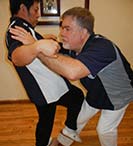 |
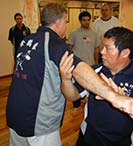 |
After intercepting an attack, Sifu Liu demonstrates on his student Fred Lohse how a hard shin kick can devastate the knee of an opponent. |
Sifu Liu demonstrates an elbow break. |
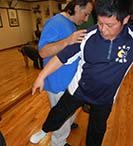 |
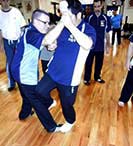 |
Sifu Liu uses a backward straight leg swing attack to an opponent's knee. |
Pinning an attacker's foot with his own, Sifu Liu shows how the inside of the attacker's leg can be attacked with a knee and shin. |
In Feeding Crane a flurry of weapons, such as fists, elbows, foot techniques and knees, are often combined in quick secession. A punch can be followed by an elbow or forearm, followed by a same side shoulder strike with foot stomp, or knee added, culminating in a dislocation or break after the opponent is controlled and his center taken over. Similar combinations are the hallmark of traditional Okinawan karate kata but are little understood.
Feeding Crane does not use fragile parts of the body such as finger tips and toes for striking. In this respect it differs from Okinawan karate which utilizes finger thrusts and toe (usually the big and second toe) kicking techniques. Sifu Liu states, "It is unfortunate if you get injured by your opponent in a fight, but more importantly you should avoid injuring yourself."
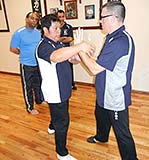 |
Sifu Liu Chang'I demonstrates use a Crane hand to control the arm of his student Michael Calandra. |
This prohibition also extends to what is known in karate as "keiko," or the "Chicken beak hand" -- striking with the finger tips clenched together, fingers extended, wrist bent. Most karate practitioners associate this weapon hand with White Crane, and many Okinawan karate masters practiced it. But in Feeding Crane it is not used. Instead,Sifu Liu uses the bent wrist for blocking (a block known as koken in karate).
This bent wrist open hand position is also used for capture and control. It is found in the arm posture,"Crane Hand," also associated with White Crane. It is seen Goju-Ryu, Uechi-Ryu and other karate kata and is thought to be some kind of block -- two arms positioned vertically in front to each side of the body, wrists bent, hands open and fingers bent downward. In Feeding Crane one application for this position is for defense against a two arm chest shove or grab -- your bent wrists angled inward or outward and draped over the attacker's arms to control or off balance.
Learning To Control
|
|
Defending against a two arm lapel grab, Sifu Liu first places both of his arms on top of the attacking forearms. He then sinks his weight downward forcing the attacker's arms down and his head forward. This is followed by a left, right elbow to the head. This is an example of controlling an opponent's arms.
|
Sifu Liu demonstrates a leg control technique on his student Michael Calandra.
|
Feeding Crane teaches a practitioner through applications how to control an opponent's arms, legs and balance. It also teaches the ability to sense and control an opponent's center. This is developed through push hands, a practice method most people know through Tai Chi.
Feeding Crane also adds a two arm variety where opponents face each other using their hands and arms to push, pull, off balance and throw an opponent. It resembles a type of standing wrestling or judo where two people grab each other and tussle and fight to control the other. A similar practice is also found in some styles of Chen Tail Chi. These exercises are largely missing from modern day karate, although a variation of single hand push hands known as kakie is found in Goju-Ryu Karate and some styles of Shorin Ryu karate. (7) A Similar of type body control is an integral part of muay thai (Thai boxing) used to create openings for close range knee kicks and elbows to the head. In terms of control antecedent parallels might be made with early sumo, or Mongolian wrestling.
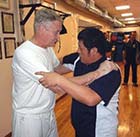 |
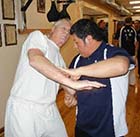 |
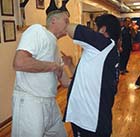 |
Fighting involves controlling your opponent. Fighters also often end up in a clinch, each person trying to control the other with their arms and weight. Here, Sifu Liu Chang'I demonstrates a simple off-balancing and control technique with Christopher Caile, a technique typical of Feeding Crane two arm push hands. |
Lifting on one side and pulling with his center on the other, Sifu Liu creates an off balance. |
In a real fight the positional advantage created by Sifu Liu's technique would provide an opening for a elbow attack to the head as demonstrated. In actual practice, however, participants generally limit their two arm push hands practice to off balancing, finding openings for technique and lightly making contact with their open hands against the opponent when an opening is created. |
Within karate kata, however, pulling, pushing, body control and off balancing techniques are very prevalent. Added to this mix are jujutsu-like arms and body manipulations, known as Chin Na in the Chinese arts. But in Feeding Crane Chin Na is secondary. Sifu Liu told me that, "We don't include this in basic practice, but we teach a little in advanced practice. We don't, however, stress this type grabbing and body manipulation." In Feeding Crane, one does not try to control an opponent through pain compliance or by locking them up. Instead, joints are targeted for quick breaking or dislocation, to incapacitate the opponent as quickly as possible.
How The System Is Practiced
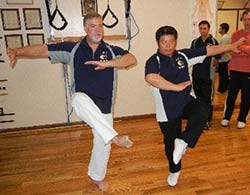 |
Sifu Liu Chang'I and his student Fred Lohse demonstrate kata to seminar participants. In Feeding Crane kata is not only used to practice technique and self defense applications. It also develops lower body strength and provides a contextual framework to practice Feeding Crane's elements of power including short power and shaking power. |
The system of Feeding Crane is practiced through basics, two person drills, and kata (21 forms). The second kata in the system is Sam Chien, or San Chin (three battles), a well known karate kata's name, but one that differs in many respects from its counterpart in Goju and Uechi Ryu as well as other Naha Te influenced styles like Seido Karate, Kyokushinkai and others. The total curriculum is complex, including Chi Kung (Qigong or internal energy work and development), body hardening, herbal medicine and other traditional practices.
When you finish practicing Feeding Crane your body feels different than after karate, taekwondo or boxing. With these arts you feel it in your muscles, but Feeding Crane is different: you feel it in your tendons and ligaments. I had a similar experience after training in some other forms of kung fu as well as a few old school forms of karate, such as those of Hohan Soken and old style body dynamics of Shorin-Ryu karate. (8)
At the end of my training with Sifu Liu I ask Fred Lohse (a well known Goju-Ryu teacher from Boston who had studied extensively with Sifu Liu Chang I for several years) how he would characterize Sifu's Feeding Crane. Lohse replied, "It is blunt force trauma to your opponent using your body's most sturdy parts." Well said.
Thunder Leads Sifu Liu To The US & Europe
If it hadn't been for "thunder," Sifu and his style might never have reached the US and Europe. Sifu told me that Kimo Wall (a famous US Goju-Ryu practitioner) while visiting Taiwan had sought his father out to find thunder. His father had passed away, however, but Sifu offered to demonstrate his kata. "When he first heard it," said Sifu "he was quiet, almost dumb struck." Kimo then told Sifu that he had been told by his Goju Ryu teachers that Miyagi Sensei (founder of Goju-Ryu karate) and other old Okinawan masters had exhibited that same sound. But after years of fruitless searching for someone with this ability on Okinawa, he had just assumed "thunder" was just another romantic story.
Kimo Wall himself added a little detail. As a child he studied Goju-Ryu in Hawaii with several teachers who had studied with Miyagi on Okinawa. Later he lived on Okinawa (stationed as a Marine) training under the Goju masters Higa Seiko and Touguchi Seiicki (both senior students of Miyagi) who went on to found their own Goju Ryu organizations.
"A number of the old Okinawan karate masters including Miyagi were known to have thunder," said Wall. He related that he was told that in the past several Okinawan karate students had traveled to Taiwan and elsewhere trying to gain this knowledge. "I had heard of Sifu Chang I's father, Liu Yin Shan, and sought him out. But I was told he had passed away, but his son offered to show me his art. I was so impressed that I convinced Sifu Liu to come to the US with me to teach seminars." For several years Kimo conducted these seminars with Sifu Liu around the US. More recently Sifu has continued to teach seminars across the US.
Fred Lohse (a student of Sifu and Goju Ryu teacher) told me a funny anecdote about Sifu Liu Chang's "thunder." A few years back a well known martial arts production company made a high quality video and sound recording of Sifu Liu's technique and kata for a DVD of his Feeding Crane. But repeatedly during recording the sound equipment kept registering unexplained sounds, something that was attributed to technical problems. Numerous adjustments and fixes, however, didn't seem to rectify the situation. Finally things were explained when technicians were told those extra sounds were the "thunder" associated with much of Sifu Liu's technique.
Final Comments
It was almost a year ago when I last saw Sifu. In one of our last conversations he commented on the loss of so much of ancient kung fu knowledge. "As to Feeding Crane," he said, "I am the only one left, as far as I know, besides my younger brother, teaching my art. I am the last direct descendant, father to son, father to son until it came to me. I am afraid it is going to get lost. That is why I am teaching you and others in the US and elsewhere: to preserve my art, my tradition, its knowledge and the old way."
I have been practicing Sifu's "short power" exercises for almost a year now. At last I am beginning to feel the snap-back of my muscles and I think I hear, ever so softly, the "kaplunk," the beginning of my own thunder emerging from my body. I will be seeing Sifu again soon in New York and hope to continue my progress.
Acknowledgements:
I want to thank Sifu Liu Chang'I for his hospitality and openness in discussing and demonstrating his art. He is a true gentleman, humble and open. I also want to thank Michael Calandra Sensei (Isshin-Ryu Karate) from New York and Fred Lohse Sensei (Goju-Ryu) from Boston who are experienced students of Sifu and who annually have hosted his seminars. They were kind enough to give advice and suggestions on this article.
Footnotes:
About The Author:
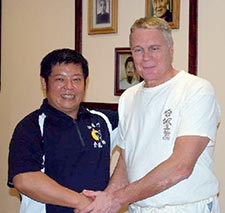 |
Feeding Crane master, Sifu Liu Chang'I and Christopher Caile, founder and Editor of FightingArts.com |
Christopher Caile is the Founder and Editor-In-Chief of FightingArts.com. He has been a student of the martial arts for over 50 years. He first started in judo. Then he added karate as a student of Phil Koeppel in 1959. Caile introduced karate to Finland in 1960 and then hitch-hiked eastward traveling through over 50 countries. Ending up in Japan (1961) he studied under Mas Oyama and later in the US became a Kyokushinkai Branch Chief. In 1976 he followed Kaicho Tadashi Nakamura when he formed Seido karate and is now a 7th degree black belt in that organization's honbu dojo. Other experience includes aikido, diato-ryu aikijujutsu, kenjutsu, kobudo, Shinto Muso-ryu jodo, kobudo, boxing and several Chinese fighting arts including Praying Mantis, Pak Mei (White Eyebrow) and shuai chiao. He is also a student of Zen. A long-term student of one branch of Traditional Chinese Medicine, Qigong, he is a personal disciple of the Qigong master and teacher of acupuncture Dr. Zaiwen Shen (M.D., Ph.D.). He holds an M.A. in International Relations from American University in Washington D.C. and has traveled extensively through South and Southeast Asia. He frequently returns to Japan and Okinawa to continue his studies in the martial arts, their history and tradition. Caile is the author of over 500 articles on martial arts and its history, Japanese art and Chinese medicine. He also edited several books on karate and Zen, contributed chapters on Qigong to books on alternative medicine, and served as a contributing writer to the Holistic Health Journal. In his professional life he has been a businessman, newspaper journalist, inventor and entrepreneur. |